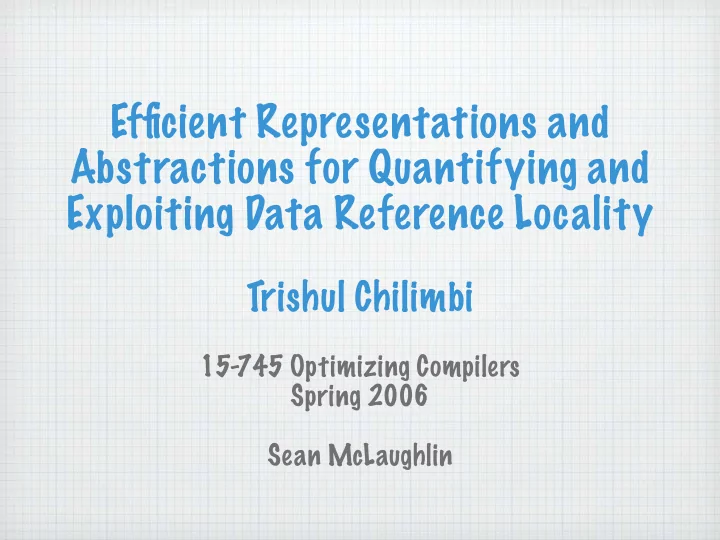

Efficient Representations and Abstractions for Quantifying and Exploiting Data Reference Locality Trishul Chilimbi 15-745 Optimizing Compilers Spring 2006 Sean McLaughlin
Memory optimizations are important!
Outline Background Defining locality Measuring locality Exploiting locality
Defining locality (textbook) temporal locality - programs reference data items that were recently referenced themselves spacial locality - programs reference data items that are close to recently referenced items Note: definitions give no metric
improving locality Clustering: Put items frequently accessed together on the same page in memory Clustering II: Align items accessed together so they land in different cache lines Pre-fetching: Load data from a lower memory layer to a higher if its use is expected in the near future
The good news Control flow graphs and program paths (Larus) capture dynamic control flow, allowing for good instruction cache behavior. Aggregate load/store analysis can yield decent page-level clustering.
The bad news Caches are too small for simple page clustering to be effective. Aggregate data access information is not sufficient for cache-level layout. Static analysis too complex on modern architectures, so use a trace Access traces are too large to analyze quickly. Need for sequences, rather than individual accesses, prevent statistical sampling.
Problem need data reference abstractions to identify and measure locality (analogous to hot program paths) need efficient data reference representation (analogous to Whole Program Paths)
Outline Background Defining locality Measuring locality Exploiting locality
Defining locality (informally) the most recently used data is likely to be accessed again in the near future Good locality implies a large skew in the reference distribution. 90/10 rule for data
Locality in terms of hottest load/store instructions
Locality in terms of data addresses
Defining locality (formally) To be exploitable by cache opts, data references must exhibit reference locality exhibit regularity regular + ref locality = exploitable locality
Abstraction: data streams A data stream is a subsequence that exhibits regularity A hot data stream also covers a large amount of the data references We formally define exploitable locality in terms of hot data streams
measuring locality We want to measure locality, as it can identify opt targets Standard “ definitions” are vague
measuring locality Inherent exploitable spatial locality = weighted average of spatial regularity across hot data streams (weight=magnitude) Inherent exploitable temporal locality = average HDS temporal regularity Realized exploitable locality = cache block packing efficiency = min/actual cache blocks needed to store stream
Exploiting locality Hot data streams + locality metric = improved data reference locality identify suboptimal programs focus opts on particular streams identify salient optimizations
Exploiting locality measures can be used to determine what combination of clustering and prefetching will be most effective, eg. hot streams with poor temporal locality are served by prefetching (not clustering) streams with poor packing efficiency can be helped by clustering
Results
Questions How is it possible that optimizing a program with such a fine grain detail helps other runs? The *measurement* of locality is wrt a particular trace of a program, even for inherent locality. Can this be made more general?
Questions Problems with the scheme? Runtime improvements? How do these memory opts interact with the scalar opts of an aggressive compiler? What about programs with sensitive input behavior? (cf. generational GC, which often behaves well, but also works terribly in some instances)
The End
Recommend
More recommend